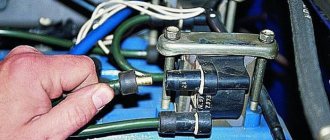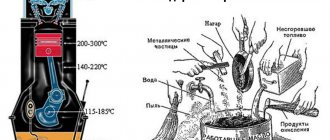News
Reviews about Autocompas.ru and the work of the staff.
A review section has been introduced on the site, using the latest technologies, now each client can write a review from their personal account.
Read completely
Automation of Returns
A completely new and intuitive returns system.
Read completely
Delivery across Russia
Global update of the “Delivery” section! Track numbers in your personal account and convenient cargo tracking.
Read completely
Updated VIN form
An updated form for creating an application for an expert to select spare parts using the vehicle’s VIN code.
Read completely
Checking the oil level in the Nissan variator
To check the oil level in the CVT on a Nissan (Qashqai j10 X-Trail T30), you need to warm up the lubricant. In warm weather, you will need to drive about ten kilometers for the oil temperature to reach 50-80 C, while in winter you will need to drive 25 km. If the oil is too hot, let it cool.
Nissan variator dipstick
Stages of checking the oil level in a Nissan variator with a dipstick
- Vehicles are installed on a horizontal surface - tilting is not allowed. The check is performed with the engine idling.
- Alternately, the lever is switched in each position (P, R, N and D) by pressing the brake pedal and held for five to ten seconds. After this, the variator is set to mode P and the brake is released.
Nissan CVT dipstick latch
- You need to open the hood and remove the dipstick from the variator neck, marked “Transmission” or CVT. To release the oil level dipstick, press the locking latch. To avoid getting dirty, it is recommended to arm yourself with special gloves or rags in advance.
- After removing the dipstick, it is necessary to thoroughly wipe it dry with a clean rag that does not leave small particles or threads, since they, as well as moisture, can lead to all sorts of problems if they get inside the variator.
- The cleaned dipstick is lowered into the neck completely without snapping the latch and is held there for five to ten seconds. After removal, a trace of oil remains on it, indicating the real level.
- The dipstick has marks for the highest and lowest permissible levels. Ideally, the oil trace on the surface of the dipstick should be in the HOT range. On different Nissan Qashqai j10, Teana models, the mark may be indicated “add – 1pt” or “don’t – full – max”.
- After determining the existing oil level in the variator, the dipstick is lowered back into the neck and securely fixed with a latch. The check is completed.
The procedure is simple and even Nissan drivers with little experience can easily cope with it. It is important that the engine does not stop idling during the procedure.
Marks on the Nissan variator dipstick
What to do if there is no dipstick?
On models Nissan JUKE, Qashqai j11, X-Trail T32 or other variations, there is a plug instead of a dipstick. In this case, checking the oil level will be more difficult. Most often, for this purpose, they contact an authorized service center, where the procedure is performed by specialized specialists.
Filler/inspection hole for Nissan variator
Those who do not want to, cannot urgently drive to a service station or want to save money, can try to check the amount of oil by draining it. The variator is equipped with a special control hole (filler hole). The box must be heated to forty degrees, and the control must be unscrewed (with the engine running). Oil begins to flow out of the channel in a thin stream. If it does not flow, you need to add until oil appears. Then the plug is screwed in and the procedure can be considered complete.
We make the dipstick ourselves
If the second method seems too complicated and time-consuming, then you can make the probe yourself. First you need to remove the plug in the place where the dipstick should be located. Next, you need to measure the depth from the edge of the box to the pallet. You can do this using a metal cable and try to find a compatible probe of the right size. An oil meter can be purchased from another Nissan model.
Sometimes they encounter a difference in length, but the dipstick can be shortened and glued into the car plug. This way, measuring the oil level in the variator will no longer be a problem.
Nissan variator dipstick
Checking the lubricant level
After the oil has been changed, it is necessary to check the operation of the on-board computer. Double-check with a dipstick to see what level of oil is poured, whether there is enough or whether there is excess. After this, turn on the car’s ignition and after the “Oil Good” message appears, press the “I” key on the car’s steering wheel or the “TRIP” button on the dashboard. The level on the on-board computer should display at least 4 bars out of 5, but better than 5 out of 5. After which it is necessary to reset the service mileage in the on-board computer.
To reset the mileage, it is not even necessary to turn on the ignition; this can be done by pressing and holding the “TRIP” key; when the mileage value starts flashing, release the button and press it again.
Do not forget to change lubricants not only in the engine, but also in other parts of the car, for example, inside the power steering, as well as the gearbox.
1.82.2 CHECKING THE ENGINE OIL LEVEL
CHECKING THE ENGINE OIL LEVEL
Engine HR16DE or MR20DE
Engine K9K
M9R engine
Normal range
MIN mark
MAX label
Caution: The engine oil level should be checked regularly, at least every time you fill up with fuel. Operating the engine with insufficient oil level can lead to engine failure. The factory warranty does not cover such cases of engine damage.
1. Place the vehicle on a level, level surface and set the parking brake.
2. Start the engine. Warm up the engine at idle speed to normal operating temperature.
3. Stop the engine.
4. Wait at least 10 minutes for the oil to drain into the engine sump.
5. Open the hood.
6. Remove the oil dipstick and wipe it dry.
• M9R engine models: The engine oil dipstick is attached to the oil fill cap. Remove the engine oil filler cap and wipe the dipstick dry.
7. Insert the dipstick completely into place.
• M9R engine models: Reinstall the engine oil fill cap.
8. Remove the dipstick again and check the oil level. The oil level must be within the range
9. If the oil level is below the MIN level, remove the oil filler cap and add the recommended engine oil to the engine. Do not add oil above the upper mark I.
10. Check the engine oil level again.
11. Replace the oil filler cap and tighten it securely.
12. Close the hood.
Typically, an engine will use some oil between changes, depending on operating conditions and the characteristics of the oil used. More oil is consumed during frequent acceleration and braking of the vehicle, and especially at high engine speeds. More frequent addition of oil may also be required during the initial period of operation of a new engine. If after a run of 5000 km the oil consumption exceeds 0.5 liters per 1000 km, you need to contact a service station.
Source
Step-by-step engine oil change
Of course, the best way to replace the oil inside the engine is at a car service center, but if you decide to save money, you can do this work yourself. Changing the oil in a Nissan Qashqai engine is carried out in several stages.
If you decide to change the oil yourself, then first find a suitable platform, preferably with a hole, for an easier oil change. Or you will need a jack.
After the place has been selected and the car has been driven into it, you should warm up the engine by setting the car to the handbrake. The oil fluid will drain from a cold engine more slowly, and some of it may even remain inside the unit. After warming up, you need to turn off the engine and wait half an hour so that, with the car standing, the lubricant drains into the lower part of the power unit.
Then open the hood of the car and unscrew the cap from the filler hole. After this, lift the car using a jack, if it is not installed above the hole.
Once you have the opportunity to crawl under the car, remove the protection on the bottom. Find the drain hole where the plug should be installed. Having previously placed a previously prepared container, unscrew the lid on the drain hole. Oil will begin to flow out almost instantly after unscrewing the plug, so be careful. Allow the oily liquid to drain for twenty minutes.
IMPORTANT: While the oil is draining from the engine, replace the old oil filter with a new one. Install carefully to avoid damaging it. This way you will save your time.
All parts removed from the engine drain must be thoroughly cleaned of old oil. After replacing the sealing washer, screw the bolt into the drain hole in its old place. Then install all the underbody protection parts, while checking all the fasteners.
IMPORTANT: The plug covering the drain hole must not be tightened too tightly on Nissan cars, as this can lead to engine damage. You can check the load on the bolt in the operating instructions.
Now you can pour oil into the car engine through the filler hole. First fill in 4 liters of oil, then, following the marks on the dipstick, add the required amount of lubricant.
After this, start the car engine and check its operation. If everything works perfectly, you can remove the car from the jack and hit the road with new engine lubricant. You can consider that the oil change in the Nissan Qashqai was completed successfully.
When is an oil change required?
First, let's look at how often the lubricant and filter are changed in the transmissions of Qashqai cars of 2008, 2012, 2014 and other years of production. According to the regulations, it is necessary to carry out the lubricant replacement procedure every 60 thousand kilometers. It must be taken into account that CVT transmissions are sensitive to off-road operation and to operating the vehicle on rough roads. This leads to rapid wear of the structural elements of the gearbox. Therefore, experts recommend changing the lubricant earlier, at least every 45 thousand km, or better yet, every 30 thousand km.
What dealers and service center representatives say
If you address this question to official dealers or representatives of service centers, you can get completely different information. Some claim that for every four thousand kilometers traveled, 500 grams of this liquid are consumed, others say that the consumption will be even greater. No matter how many surveys you do, you will get so many completely different opinions.
In fact, if the car is in perfect condition, then the volume of oil poured into the engine should be almost completely preserved until the next change! After all, this is not gasoline or diesel fuel, which is burned during the operation of the power unit. And this applies to absolutely any car brand, including Nissan Qashqai.
Oil change progress
Now we move on to the most important stage, which involves directly changing the oil in the Nissan Qashqai engine with your own hands. We warn you right away that it is best to carry out all subsequent manipulations only on a fully warmed-up engine, then it will be easier to drain the waste. Drive your vehicle into the pit; if this is not possible, no problem, just use a jack. Now remove the underbody protection.
After this, you can easily find the drain hole. Use a wrench and unscrew the engine sump drain plug and immediately place a prepared container under it.
The waste will begin to flow into it; it will have a dark tint, informing you that there are traces of combustion in the oil liquid. The darker the motor fluid, the older it is. It will drain for several minutes, do something else so as not to interfere with the draining process. After the last drop has stopped flowing from the engine, we strongly recommend that you remove the old filter.
Here you can arm yourself with a wrench, a screwdriver - anything, as long as you can remove the no longer usable filter. Feel free to throw it away, lightly fill the new one with fresh oil, wipe its gasket and the sealing ring of the drain hole with oily liquid.
Install a new filter and tighten the drain plug.
Now you need to unscrew the filler cap and start pouring new engine fluid into it. You can slowly pour in a thin stream, however, not everyone is able to perform such actions with minimal losses, so it is best to take a funnel and pour new oil through it.
Tighten the plug, and then inspect the entire surface of the engine. If you find a trace of oil on the surface of the neck, on the engine or anywhere else, be sure to wipe it off with a dry cloth, because when the engine heats up, the oil will burn, emitting extremely unpleasant odors. At the end of the manipulation, we recommend that you check the level of the filled fluid to make sure that the required amount of oil is in the engine. If an oil mark on the dipstick indicates a lack of engine oil, start adding little by little until you reach the desired amount. Now you can safely start the engine and go on your next trip.
So, you are convinced that changing the oil in a Nissan Qashqai engine is much easier than learning to drive a vehicle. We wish you that all your affairs will go smoothly, that you carry out all technical procedures independently and effectively.
The most popular reasons for excessive oil consumption on Nissan Qashqai
If a car owner observes high oil consumption in this Japanese crossover, then something is clearly wrong with the vehicle. There are a number of possible reasons leading to this problem:
- The sealing elements are worn out and fluid leaks through them. They will need to be replaced, and the fastenings themselves will need to be rechecked for possible weakening;
- The crankcase ventilation system is excessively clogged. The solution is to organize flushing of the entire system;
- The piston rings or cylinders of the power unit are in poor condition. The rings and pistons will most likely have to be replaced, and the cylinders themselves will have to be bored;
- Previously, the car owner used oil that was not recommended by the car manufacturer. As a result, this led to coking of the oil scraper rings and grooves that are in the piston grooves. All this will need to be thoroughly cleaned and in the future use only acceptable products;
- The special oil seals that are installed on the valves are heavily worn or have obvious damage. They will need to be replaced with new ones;
- The valve guides or valve stems are worn. It will be necessary to replace elements and repair the entire cylinder head.
That is, almost always the detection of excessive consumption of this fluid implies the presence of one of the serious problems, which is very important to eliminate as quickly as possible. After all, this is always a waste of money and the likelihood of other troubles in the foreseeable future.
6.2.8 Oil level monitoring system
Oil level control system
Models produced from 06.1993 to 05.1997
The oil level monitoring system consists of an oil level sensor, which is screwed through the oil drain hole, and a warning lamp on the instrument panel. The oil level in the pan begins to be controlled at an oil temperature of +60 “C.
The oil level in the pan is determined using a float. When the oil level is low, under the influence of a magnet in the float chamber, contact 8 closes (Fig. 5.19), and a warning lamp lights up on the instrument panel. When the oil level drops due to driving conditions, the warning light first flashes and then stays on.
Rice. 5.19. Oil level sensor: 1 - oil pan; 2 - sealing ring; 3 — oil level sensor; 4 — ventilation hole with a diameter of 8 mm; 5 - drain hole with a diameter of 4 mm; 6 — float; 7 - magnet; 8 — sensor contact; 9 - bimetallic washer-valve
In order to avoid unnecessary warnings associated with driving modes, for example when making a sharp turn, a deceleration relay is installed in the control unit. It turns on the warning lamp if the low oil level signal is given within 60 s.
To avoid incorrect readings when the engine is cold, when unheated oil drains into the oil pan for a long time, the oil level sensor is equipped with a bimetallic valve that prevents oil from draining from the float chamber. The oil level sensor ensures that the warning lamp on the instrument panel turns on shortly before the oil level reaches a minimum.
Models produced from 07.1997 with the ASSYST maintenance system
The oil level sensor transmits readings to the ASSYST active service system unit. A microcomputer, based on information received from various sensors, such as oil level and temperature, coolant temperature, speed, engine speed and load, records the actual condition of the engine oil and draws up a plan for engine care. One of the indicators of oil “aging” is the content of iron particles in it, which increases sharply after 5000 km when driving short distances. Mercedes-Benz has developed a special touch sensor. It heats up when the oil level is high or low, detects when the oil needs to be changed, as well as changes in the structure of the oil, such as metal additives, fuel or coolant, and alerts the driver. Information about high or low oil level is displayed on the instrument panel display.
Automatic indication
The automatic indication begins to operate no earlier than 60 s after starting the engine and at an oil temperature of more than +60 °C.
If the oil level exceeds the norm, the “oil can” symbol with the inscription “OLSTAND UBER MAX” is displayed on the instrument panel, accompanied by a sound signal. Excess oil must be removed.
If the oil level in the pan is low, the “oil can” symbol with the inscription “OLSTAND UNTER MIN” is displayed on the instrument panel, accompanied by a sound signal. In this case, it is necessary to replenish the oil level to normal as quickly as possible.
If the amount of oil is too low, the “oil can” symbol with the inscription “OLSTAND MINIMUM” (oil level below acceptable) is displayed on the instrument cluster, accompanied by an audible signal. In this case, it is necessary to immediately replenish the oil level to normal.
NOTE
For vehicles that do not have a multifunction indicator, the indication “-2L” is displayed next to the “oil can” symbol.
WARNING
Information about the oil level does not change during the filling process. The system must be manually queried about the amount of oil in the engine.
Recalling information manually
Turn off the ignition. Set the ignition key to position “2”. After 10 seconds, the instrument cluster will display the message “OLSTAND ANZEEIGEN?” (“Show oil level?”) and the “oil can” and “clock” symbols will light up.
At this time, within one second, press the reset button twice for the daily mileage counter. After some time, a message will be displayed, for example, “1.0 L 01 einfullen” (“Fill with 1.0 l of oil”). The message will not appear immediately: at an oil temperature of +60 °C, the waiting time will be 1 minute.
Removing and installing the oil level sensor
SEQUENCE OF WORK
Removal
1. Remove the engine compartment shield from below.
2. Drink or pump out the engine oil using a vacuum unit.
3. Disconnect contact connector 1 from the oil level sensor (Fig. 5.20).
Rice. 5.20. Removing the oil level sensor: 1 - contact connector; 2 - sealing ring; 3 — oil level sensor; 4 - bolt
4. Unscrew bolt 4.
5. Tilt the oil level sensor 3 and remove it from the oil pan.
Installation
6. Install oil level sensor 3 with a new sealing ring 2 and tighten bolt 4 with a torque of 10 Nm.
7. Connect pin 1 to the sensor.
8. Install the engine compartment shield from below.
9. Fill the engine with engine oil.
10. Warm up the engine during a test drive and check the sensor for leaks.
Addition for 6-cylinder V-engine:
1. Remove the lower part of the oil pan.
2. Unscrew the mounting screws (Torx) from the bottom of the oil level sensor next to the oil pumping pipe.
3. Tighten the oil level sensor mounting bolts to a torque of 10 Nm.
Checking the oil level sensor
SEQUENCE OF WORK
The oil level warning lamp lights up when the oil level is normal and the engine is running.
1. Disconnect the oil level sensor connector.
2. Using an ohmmeter, check the contact between the sensor and ground.
3. If there is no contact, remove and replace the sensor.
4. If there is contact on the sensor, check the transfer sensor circuit to the instrument cluster.
5. If the circuit is working properly, then the cause of the malfunction may be a defect in the instrument cluster.
The warning lamp does not light up when the ignition is turned on
6. The lamp may have burned out. Replace it.
The warning lamp does not light up when the engine is running, the oil temperature is more than +60 C and the oil level is below the minimum mark
7. Disconnect the wire from the sensor.
8. Check the contact between the sensor connector and ground.
9. Under the conditions described above, there should be no contact on the sensor. Possible circuit break.
10. If the lamp does not turn on, even though there is a contact on the sensor, the lamp has burned out.
11. If there is no contact on the sensor, remove, check and, if necessary, replace the sensor.
Lubricant selection
Original oil for Qashqai variator
In order for the J11 CVT transmission or other Nissan gearbox to work without interruptions, only high-quality lubricant must be poured into it. Using low-quality transmission fluid will lead to transmission malfunctions.
The manufacturer recommends pouring original Nissan CVT Fluid NS-2 lubricant into Kashkaev gearboxes.
To avoid purchasing a counterfeit product, when purchasing, pay attention to the code indicated on the label. For original products it is KLE52-00004. In principle, it is also possible to use other analogues if you cannot buy the original product. But the manufacturer recommends not to experiment.
Which oil to choose for replacement
From the factory it is recommended to fill in synthetic oil with a viscosity of 5W-40. Original Nissan oil in a 5 liter plastic canister can be ordered using code KE900-90042 . The cost of a canister of oil at the moment is more than 2000 rubles. Depending on your preferences, you can also choose oils similar to other manufacturers.
Analogues of the original oil
- CASTROL Magnatec 5W40 A3/B4 (4 l.) canister price from 1900 rub.
- LIQUI MOLY Synthoil High Tech 5W40 (4l.) synth. (article: 1915) price from 3000 rub.
- Mobil Super 3000 X1 5W40 (4L) synth. ((article: 152061) price from 1900 rub.
- Shell Helix Diesel Ultra 5W40 (4 l.) syn. (gray) (article: 550040558) price from 2500 rub.
- Shell Helix HX7 5W40 (4l.) p/synth. (blue) (article: 550040341) price from 1500 rub.
- Total Quartz 9000 5W40 (5 l.) syn. (article: 173574) price from 2200 rub.
- ZIC X9 5W40 SN (4L) synth. (article: 162613) price from 1450 rub.
- Rosneft Premium 5W40 SM/CF (4 l.) synth. price from 1300 rub.
When purchasing oil in 4 liter cans, you will need to purchase another 1 liter for refilling.
Engine oil volume Nissan Qashqai
- Engine 1.6 - 4.3 liters
- Engine 2.0 - 4.5 liters
As you can see, depending on the engine size, different amounts of oil are required.










